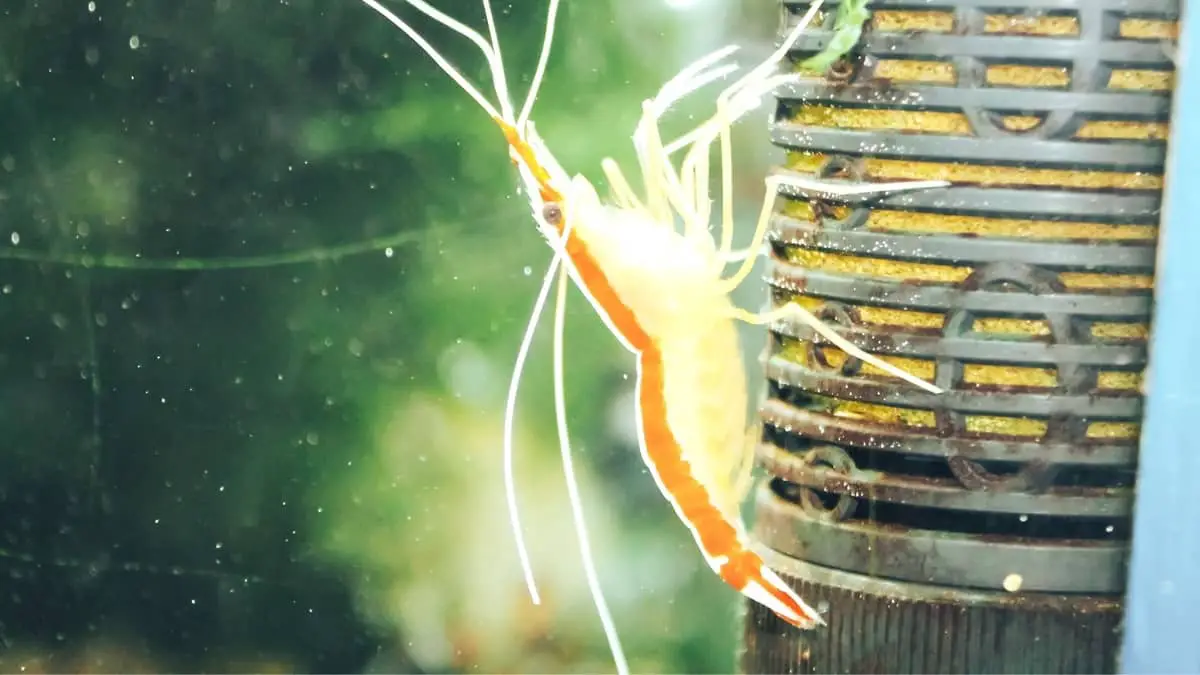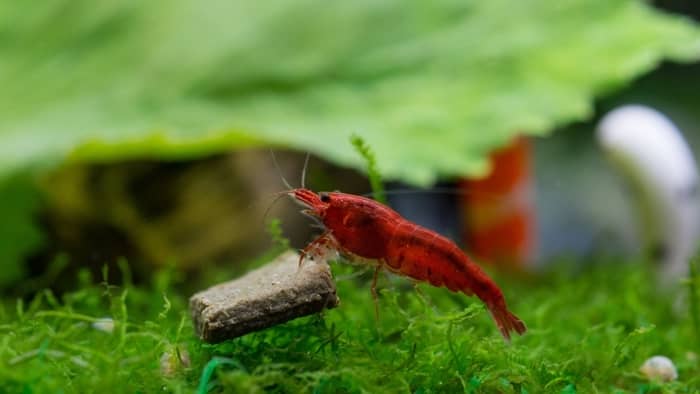Last Updated on January 23, 2022 by Fabiola L.
So, you’ve decided to raise shrimp but are unsure of what they eat. You’ve come to the perfect place to discover the surprising things that shrimps eat in a fish tank. Hopefully, you will leave here feeling more optimistic and excited to start your shrimp-raising journey!
Just like humans, all life needs food. Some species have a more diverse range of what they can eat than others. Lucky for you, shrimps are not picky!
What Do Shrimps Eat?
In the natural environment, shrimps usually eat anything that has sunk down to the bottom of the ocean. According to the U.S. Fish and Wildlife Service, “shrimps are nature’s garbage collectors.” This includes algae, worms, decaying fish, fish poop, and even other dead shrimp!
The same thing applies in your ecosystem. They will eat any decaying matter that is present.
Shrimps are omnivores, which means they eat both plants and animals. In your system, you can try your best to mimic their natural diet.
Be sure to provide plenty of plant life for them to eat. This can be easily achieved by keeping an adequate amount of plants in your ecosystem. You can also feed them fresh veggies like spinach, kale, cucumbers, and carrots.
I highly recommend that you use organic produce and clean/peel the veggies before giving them to the shrimp. You can even boil the veggies for a few minutes before feeding them to make it easier for the shrimp to digest. Make sure to cool them off before adding them into the tank.
This process can be done a few times a week- pay attention to how much your shrimps consume and base your judgment on that. Any excess buildup of food will need to be cleaned out.
Another simple resource in abundance all around are dying leaves! This is a very convenient and free food you can give to your shrimps.
On your next walk, collect the leaves from outside, break them into smaller pieces and drop them in. It’s as easy as that. You only need one to two leaves per 10 liters of tank water.
Make sure to find clean leaves without anything on them- the best way is to grab some dried leaves directly off the tree. If you want to make sure the leaves sink to the bottom, you can also soak them in hot water prior to feeding them to the shrimp.
In the fish tank, shrimps will be a handy tool in keeping your tank clean. They feed off of algae that has built up on the tank and uneaten food that sinks to the bottom! In fact, algae will be a huge source of nourishment for shrimps, so make sure you put your shrimp into an already existing ecosystem with lots of algae build-up.
Learn more about: Quick and Easy Ways To Reduce Nitrites In Your Fish Tank!
Sources Of Animal Protein
Protein and nutrients from animals is also an important supplement to provide to your shrimp. If you want to save money, you can make your own food at home. This will also help you know exactly what is going into your shrimp’s bodies.
In nature, shrimps get protein from decaying fish parts, mosquito larvae, and fish droppings. Even parts of a dead shrimp can be consumed. If you have enough life in your tank, there should be adequate protein available.
Shrimps are not very particular, so there isn’t a huge need to buy factory-made food. However, if you need to buy food be sure to look at the balance between the plant ingredients and animal protein. You want to buy something that contains a majority of plant materials.
Also, pay attention to the source of protein in this food- it should match what shrimps can find in the wild. Give protein supplements two to three times per week maximum.
One great source of calcium for shrimps is dried cuttlefish bone. This can be easily found at most pet stores. Place it at the bottom of your tank for your shrimps to graze whenever they please.
Read more about What Are Mosquito Dunks? Find Out Now!
Shrimp Characteristics
There are so many different shrimp species. Of course, the nature of shrimp depends on the exact variety. However, many of them share some similar characteristics. Most shrimps are of a semi-translucent color which makes it difficult for predators in the water to spot them.
Another commonality is that in order to grow Shrimps need to “molt”, which means to shed their skin. This is the process of getting rid of its exoskeleton, or outer shell, in order to grow. Basically, they are growing a larger shell to live in as they age!
How Often Do Shrimps Molt and How Do They Reproduce
The age of the shrimp determines the rate at which the shrimp sheds. Typically, a younger shrimp will molt every one or two weeks. As they grow older, this will slow down to once every three to four weeks.
The reproduction method of shrimp is also very interesting. When it is mating time, female shrimp will secrete hormones into the water to attract the male. The male shrimp then combines the sperm with the female to create eggs.
The eggs are stored underneath the tail of the female shrimp. Keep your eyes out for the eggs- they are quite spectacular to see! Shrimps use their tails to “fan” their eggs to keep them safe and ensure they grow healthily.
On average, they keep between fifty and one hundred eggs per litter.
Now you can see the flexibility of what shrimps eat in a fish tank. This relaxed diet makes it easy to raise shrimp at home. Shrimps are great additions to any system because their bottom feeder qualities really help to keep the tank clean.
Going with a natural, homemade diet also means that you don’t have to spend much money to purchase outside food. Make sure to check the specific requirements for the species you choose. No matter what, it should be a fun and not too stressful journey!
Good luck and please feel free to comment and ask questions below!

Candace is an aquaponics expert with over 5 years of experience in the field. She has a degree in environmental science from the University of California, Berkeley and a degree in aquaponics from the University of Florida. She is passionate about sustainable agriculture and has a deep knowledge of aquaculture and hydroponics. She has worked on numerous projects and has been involved in the development of aquaponic systems and fish farms. She also has experience in designing and constructing aquaponic systems. With her expertise, Candace is able to advise clients on the most effective and efficient way to construct and manage their aquaponic system. She is an active member of the aquaponic community, often speaking at conferences and seminars. Candace is dedicated to helping others understand the importance of aquaponics, and she is a strong advocate for sustainable food production.



